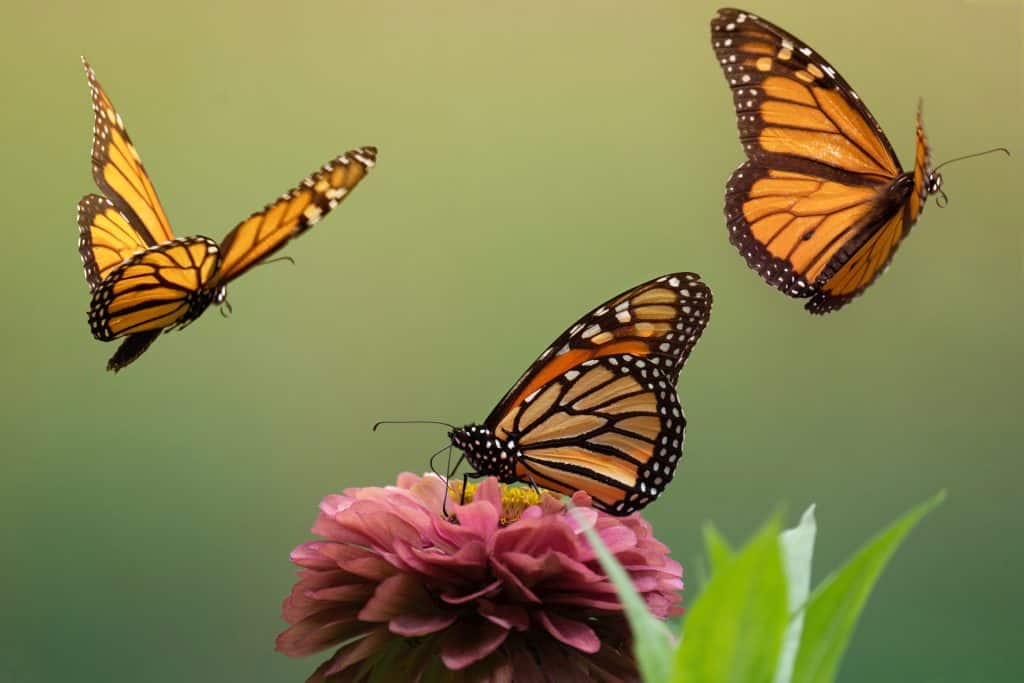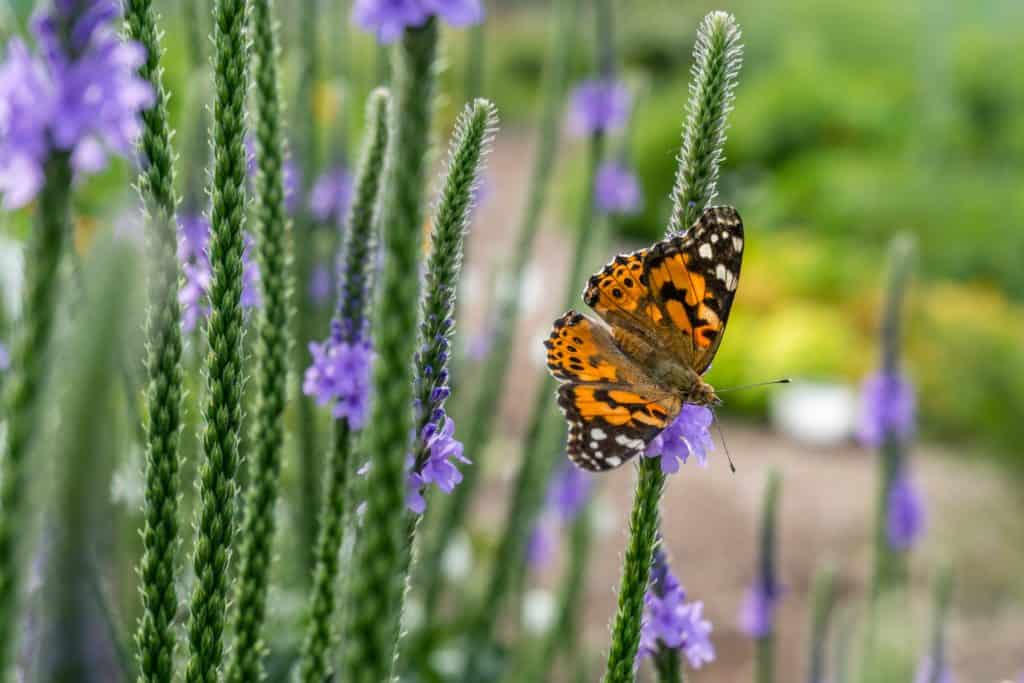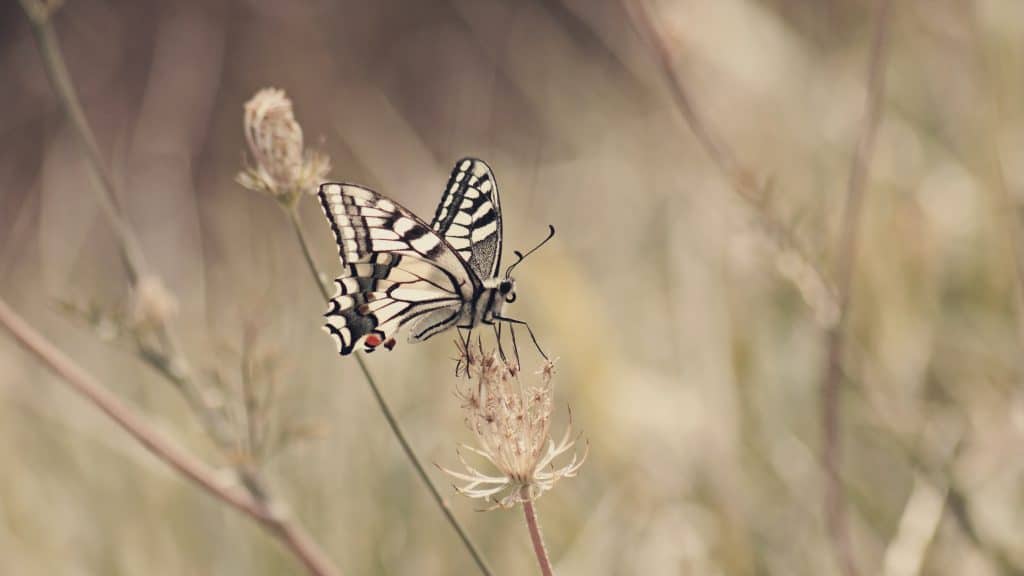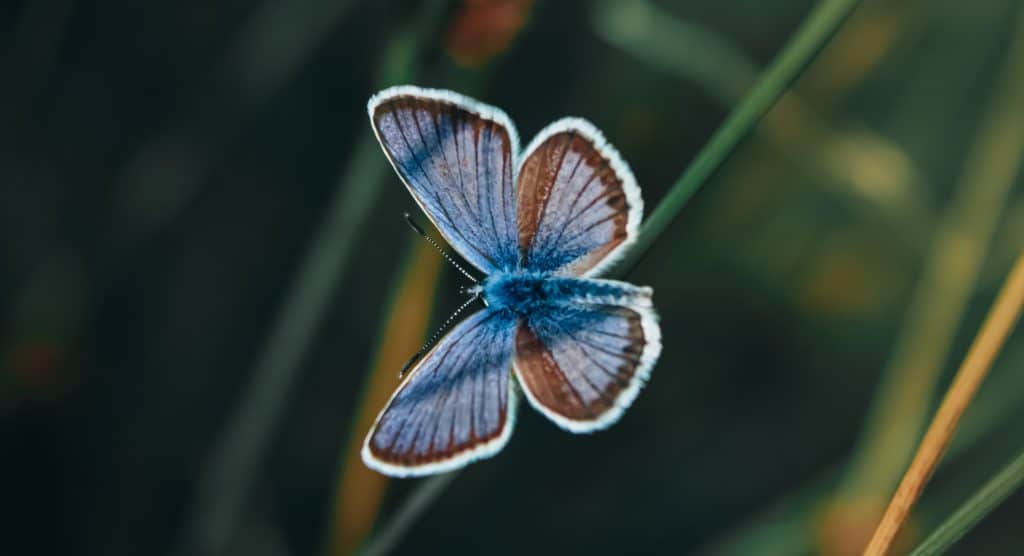Butterflies are one of the most beautiful flying creatures on the planet. Their delicate wings and vibrant colors can make them a joy to behold, but what may be less considered is where they call home.
Butterflies can live in a variety of habitats, including meadows, gardens, forests, and deserts. In each of these habitats, they need to find food and water sources, shelter from predators, and ideal temperatures to promote development. Butterflies will typically migrate between areas depending on the season or if the habitat is disturbed.
With over 700 butterfly species found in the United States, it’s easy to spot these dazzling creatures throughout the year. While some spend summer months fluttering around meadows and gardens, others migrate to southern states, such as Texas, Arizona, and California, during winter- seeking refuge from colder temperatures. But don’t be fooled! Certain butterfly species have been known to brave icy conditions up north, as in Minnesota and Wisconsin, and stay put if favored by their climates.
It’s important to understand what type of environment a butterfly needs to thrive.
What is the Typical Habitat of a Butterfly?
A diversity of habitats is necessary for butterflies since different species require different conditions in order to survive. Some butterflies prefer more tropical climates with more lush vegetation and densely forested areas, while others can tolerate harsher environments such as deserts or cold mountainous regions. Additionally, some species need specific plants or flowers that grow in their natural habitats for sustenance and breeding.

Monarch butterflies, for example, might lay their eggs on milkweed plants in temperate regions such as North America or Europe during their annual migration. The caterpillars will feed on the milkweed leaves until they enter the pupal stage. Meanwhile, Painted Lady Butterfly larvae feed on thistle plants, which can usually be found near roadsides and pastures throughout much of Europe and North America as well.
Habitat destruction due to deforestation and land development can cause serious declines in butterfly populations in certain regions of the world. This makes it even more important that we protect existing habitats by conserving nature reserves or planting gardens that attract these species of butterflies. Not only will this help ensure that future generations get to enjoy these stunning creatures buzzing around us, but also helps maintain a healthy ecosystem balance overall.
- Different species of butterflies require different habitats in order to survive
- Some butterflies prefer more tropical climates with lush vegetation and densely forested areas
- Others can tolerate harsher environments such as deserts or cold mountainous regions.
- Habitat destruction due to deforestation and land development can cause serious declines in butterfly populations
Key Takeaways
Different Types of Butterflies and Their Preferred Habitats
Monarch Butterfly:

Monarchs are arguably the most recognizable species of butterfly, with their striking orange and black wings and large size. They can be found in almost any temperate habitat from North America to Australia, although they usually avoid wetter climates such as rainforests. The caterpillars feed on the leaves of a variety of milkweed plants, which provide them with both sustenance and protection from predators. During migration season, these butterflies will travel thousands of miles in search of warmer climates to overwinter in.
Painted Lady Butterfly:

Painted lady butterflies are brightly colored creatures that inhabit sunny meadows, grasslands, and deserts across much of the world. The larvae feed primarily on thistle plants, while the adults sip nectar from a variety of wildflowers. Most Painted Lady Butterfly populations remain relatively stable year-round, but some migrate up to 2,000 miles each year as part of their seasonal cycle.
Swallowtail Butterfly:

Swallowtail butterflies are widely recognized for their colorful wingspan and distinctive tails. These majestic creatures can be found living in various tropical or subtropical habitats ranging from open woodland areas to mountain peaks. Swallowtails tend to lay eggs mostly on host plants specific to their species such as rue or carrots; thus providing food for their larvae when they hatch out into caterpillars.
Gossamer Winged Butterfly:

Gossamer-winged butterflies have unique iridescent wings that make them easily distinguishable from other species. They like warm climates and prefer to live in grassy fields and other open landscapes such as meadows or wetlands – far away from trees that would otherwise shade them from direct sunlight. Their diet consists mostly of nectar obtained by feeding on wildflowers around these areas during the day.
No matter where they live, butterflies require specific environments to survive and thrive throughout the different stages of life. By understanding these habitats better, we can help create more sustainable solutions for preserving existing populations as well as help reintroduce new ones back into our local ecosystems when necessary – making sure beautiful creatures like these remain part of our natural world for generations to come!
- Monarch butterflies can be found in temperate habitats worldwide.
- Painted lady butterflies inhabit sunny meadows, grasslands and deserts
- Swallowtail butterflies can be found living in various tropical or subtropical habitats
- Gossamer-winged butterflies like warm climates, and prefer to live in grassy fields far away from trees.
Key Takeaways
Factors that determine a butterfly’s habitat
When deciding on a habitat, butterflies look for certain factors that will help them survive and reproduce. They need to find an environment that offers both protection from predators as well as an abundance of food sources. Additionally, many species of butterflies also require specific climate conditions in order to make sure their larvae are able to reach adulthood.
Climate
Temperature is a major determining factor for butterfly habitats. Butterfly species living in colder climates must migrate south during the winter months in order to ensure their survival. These migrations can cover hundreds or even thousands of miles and are one of the most spectacular natural phenomena on earth. Similarly, butterflies living in warmer climates often hibernate during periods of extreme heat or drought, waiting until more favorable conditions return before resuming activity.
Plant life
In addition to temperature preferences, different butterfly species have evolved to take advantage of various host plants. For example, Monarch Butterfly larvae feed primarily on milkweed plants while Painted Lady Butterfly larvae prefer thistle plants found near roadsides and pastures throughout much of Europe and North America respectively. Additionally, some species like Swallowtails typically lay eggs on particular host plants such as rue or carrots; thus providing food for their larvae when they hatch out into caterpillars.
Light Availability
Lighting is another factor influencing butterfly habitats since many species require direct sunlight for thermoregulation (maintaining body temperatures). As such, most butterflies avoid heavily forested areas where shade would otherwise inhibit their ability to absorb heat energy from the sun’s rays.
On the other hand, certain species such as Gossamer-winged butterflies actually prefer open landscapes with plenty of sunshine – places like grassy fields or meadows are ideal because they receive maximum exposure from the UV light necessary for thermoregulation but still provide some hiding spots nearby if needed for protection from predators.
Water availability
Finally, the availability of water is another important factor influencing the selection of a butterfly’s habitat; some species may stay longer in areas with ample water sources while others may move away quickly if rainfall levels drop too low and food becomes scarce due to drought conditions.
Such changes can cause serious fluctuations in butterfly populations all over the world so it’s important that we remain vigilant and do our part by preserving existing habitats or planting gardens that attract these amazing creatures back when needed!
- Butterflies look for an environment that offers both protection from predators as well as an abundance of food sources.
- Temperature is a major determining factor for butterfly habitats.
- Different butterfly species have evolved to take advantage of various host plants.
- Lighting is another factor influencing butterfly habitats since many species require direct sunlight for thermoregulation.
- The availability of water is another important factor influencing the selection of a butterfly
Key Takeaways
How to Create a Natural Home for Butterflies in Your Garden?
Creating a natural home for butterflies in your garden is an incredibly rewarding experience. Not only are these beautiful creatures enjoyable to watch, but they also play an important role in pollination and the greater ecosystem. Whether you’re a beginner or a seasoned gardener, there are several steps you can take to make sure your garden is hospitable and supportive of butterfly populations.
First and foremost, it’s important to understand that adult butterflies need host plants that provide food for larvae as well as nectar-producing flowers for adults. Butterfly larvae feed exclusively on certain species of plants so when selecting yours, make sure you choose ones that are appropriate for the type of butterflies native to your area. A few good examples include milkweed for Monarchs and thistles for Painted Ladies – both of which will help encourage more growth in your garden.
When planting, it’s also important to remember that different butterfly species prefer different environments so you should try to create a variety of habitats around your property. If possible, add sunny spots as well as shady corners where butterflies can rest during the hottest parts of the day. When adding trees or shrubs be sure to include some with bark crevices – these offer great hiding spots from predators! And don’t forget about water – butterflies need sources close by if they’re going to stick around; birdbaths and puddles work great for this purpose.
Adult butterflies require nectar-producing flowers to survive so be sure you have a number of those available too! Butterfly gardens should feature blooms with long, flat petals like coneflowers or daisies; these types of flowers have easily accessible nectar which makes them ideal sources of food for visiting insects. Additionally, avoid using any pesticides or herbicides since these chemicals can destroy not just butterflies but entire populations if not used properly and with caution!
Finally, minimize human interference whenever possible since excessive foot traffic or loud noises may frighten away local butterfly populations looking for a place to lay eggs or find nectar sources. Leave areas undisturbed and consider leaving piles of woodchips with leaf litter beneath them – these serve as inviting homes for many species and help create diverse habitats within your garden!
Creating a natural home for butterflies doesn’t have to be complicated; simply follow the above guidelines and soon enough you’ll see plenty of beautiful creatures fluttering around each year – happy and healthy thanks to a home designed especially for them!
Benefits of Having a Diverse Range of Butterfly Species in Your Area
Having a diverse range of butterfly species in your area can be beneficial in several ways. Butterfly populations are an important part of the ecosystem and provide many services to humans, such as pollinating crops and producing honey. Butterfly populations also act as indicators for environmental health, responding quickly to changes in the environment and providing clues about how our actions are affecting the environment.
By increasing the diversity of butterflies in an area, not only will a wider variety of food sources become available for them but predators (such as birds) will become less of a threat. A diverse range of species allows for genetic variation within groups, which helps encourage healthy populations with strong immune systems.
This reduces competition between different species over food resources and habitat, allowing for more sustainable growth. Furthermore, introducing different species into a local ecosystem will help create an even balance between plant and animal life as all species work together to maintain a healthy ecological cycle.
The presence of diverse butterfly species is also aesthetically pleasing; having butterflies visit flowers scattered across your garden can make it come alive! Watching these creatures flutter around is especially rewarding when you’ve taken the time to carefully cultivate your landscape so that it’s welcoming to butterflies from different areas.
Not only does this bring joy but it also aids conservation efforts – seeing a wide variety of butterflies can help remind people that we need to do more to protect their habitats before certain species are forced into extinction due to our actions.
Diversity among butterfly populations is something that should be encouraged because it allows us to learn more about the ecology surrounding us while aiding in our own conservation efforts. By planting nectar-producing plants or creating wildflower meadows that attract many different kinds of butterflies – we’re ensuring that our environment remains healthy while still being able to enjoy its beauty!
Protecting Butterfly Habitats
Protecting the habitats of butterflies in your local area is a great way to help ensure their survival. Here are some tips to get you started:
Start with your Backyard
Create a butterfly-friendly habitat in your garden or backyard. Plant native flowers which provide nectar for adult butterflies and host plants for caterpillars such as milkweed, thistle, and dill. Butterfly bushes are also beneficial, providing shelter and food sources throughout the year.
Additionally, avoid using any pesticides or herbicides that may have detrimental effects on local species – organic methods are best!
Join a Conservation Community
Consider participating in conservation efforts organized by local organizations. These efforts can involve planting trees or shrubs that provide food and shelter for butterflies, removing invasive species from butterfly habitats, or creating educational materials to spread awareness about their plight in your community.
Participating in these initiatives is a great way to support Butterfly Conservation efforts while also helping protect their habitats close to home.
Mind your environmental footprint
Third, make sure you’re taking steps to reduce your own environmental footprint as well. Butterfly populations are sensitive to water quality and air pollution so reducing emissions from vehicles, disposing of chemicals properly, and conserving energy use are all great ways to help protect these creatures from harm.
Moreover, be mindful of urban development projects since they can lead to the destruction of vital butterfly habitats over time; you can work with local groups to advocate for sustainable development practices within your community which will benefit both humans and wildlife alike!
Educate Others
Finally, educate others about the importance of Butterfly Conservation. Inform them about the threats facing Butterfly populations worldwide due to climate change as well as discuss how we can all do our part in protecting them locally through simple steps.
This can be like planting Butterfly-friendly flowers or joining conservation efforts when available near you! Sharing knowledge is key – so talk to friends and family members about Butterfly Conservation whenever possible – this could be especially helpful if they live near Butterfly habitats that may be at risk from human activities or if they’re looking for ways to lend support from home.
By taking these steps now we can help protect butterfly habitats near us today – but also protect our environment for future generations tomorrow! Supporting Butterfly Conservation not only safeguards these beautiful creatures but opens up opportunities for us all to learn more about nature’s balance – something that could benefit us immensely in the long run!
Conclusion
Butterfly Conservation is a complex endeavor that requires us to take into account both environmental protection and local community engagement. Butterfly habitats should include native plants, trees, shrubs, and water sources like shallow ponds to attract Butterfly species and create diverse ecosystems.
Additionally, research must be conducted into the impact of pesticides and other chemicals used in agriculture so as not to endanger Butterfly populations. Furthermore, educational initiatives such as forming wildlife clubs for children or setting up public events with lectures can help spread awareness about Butterfly habitats near us today and how we can protect them from destruction due to urban development projects.
With these efforts combined together – environmental protection along with local community engagement – we will be able to ensure that our environment remains healthy while still being able to enjoy its beauty!
Recent Posts
How Can I Create A Habitat For Skipper Butterflies In My Garden With 3 Easy Plants
Skipper butterflies are a diverse group of insects that are found all over the world. They are known for their quick, darting flight and their often colorful wings. Skippers are attracted to...
Common Species Of Butterflies In Maryland: 21 Unique Species
Maryland is home to a variety of beautiful butterflies, from the large and showy Eastern Tiger Swallowtail to the tiny and delicate Blue Dasher. There are over 150 species of butterflies in Maryland,...
